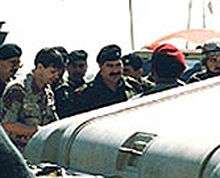Sultan Hashim Ahmad al-Tai
| Sultan Hashim Ahmad al-Tai | |
|---|---|
 Ahmad in December 2004 | |
| Iraqi Minister of Defence | |
|
In office 1995–2003 | |
| Prime Minister | Saddam Hussein |
| Preceded by | Ali Hassan al-Majid |
| Succeeded by | Hazim al-Shaalan |
| Personal details | |
| Born | Mosul, Iraq |
| Political party | Arab Socialist Ba'ath Party |
| Military service | |
| Allegiance |
|
| Service/branch | Iraqi Army |
| Years of service | 1960–95 |
| Battles/wars |
Iran–Iraq War Persian Gulf War |
Sulṭān Hāshim Aḥmad Muḥammad al-Ṭāʾī (Arabic:سلطان هاشم أحمد محمد الطائي) is a former Iraqi military commander, who served as Minister of Defense under Saddam Hussein's regime. Considered one of Iraq's most competent military commanders, he was appointed to the position in 1995. During his thirty-year military career, Sultan commanded two brigades, three divisions, and two corps of regular army corps before assuming responsibilities as Minister of Defense.
Career

Persian Gulf War
Ahmad served in the Iraqi Army during the 1980–1988 Iran–Iraq War and later in the Persian Gulf War, signing the ceasefire that ended it. He survived several purges and became the highest-ranking general in the Iraqi Army. He was regarded largely as a figurehead in the Iraqi military without any amount of real control.
Iraq War
As the invasion of Iraq loomed, it was reported in The Guardian in February 2003 that Ahmad had been placed under house arrest by Saddam Hussein, in a move that was apparently designed to prevent a coup. Nevertheless, he continued to appear on Iraqi state-run T.V., to preserve a sense of normality.
Ahmad was number 27 on the United States' list of most wanted former Iraqi officials. On September 19, 2003, after nearly a week of negotiations, he gave himself up in Mosul to the 101st Airborne Division (Air Assault). Dawood Bagistani, who arranged the surrender to Maj. Gen. David Petraeus, said Ahmad was handed over "with great respect" and was with his family at the time. Bagistani said the U.S. military had promised to remove Ahmad's name from the list of 55 most-wanted, meaning he would not face indefinite confinement and possible prosecution. "We trust the promise," Bagistani said.
Special treatment for Ahmad could be an effort to defuse the guerrilla-style attacks that were taking a toll on American soldiers. Many of the attackers are thought to be former soldiers in Saddam's army. Seeing their former military leader well-treated by the Americans might have encouraged them to lay down their arms.
On June 24, 2007 he was sentenced to death by hanging for War Crimes and Crimes against Humanity. His execution was scheduled for September 11, 2007, but his execution was never carried out because of public disapproval from Iraq's president and vice-president.